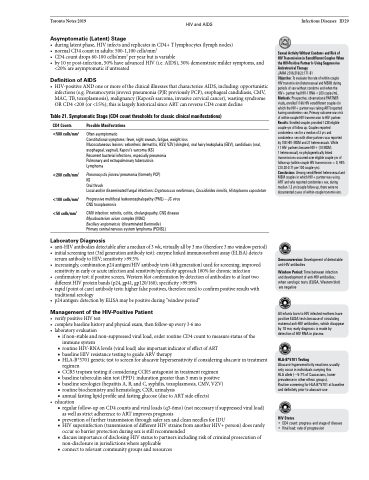Page 629 - TNFlipTest
P. 629
Toronto Notes 2019 HIV and AIDS
Asymptomatic (Latent) Stage
• duringlatentphase,HIVinfectsandreplicatesinCD4+Tlymphocytes(lymphnodes)
• normalCD4countinadults:500-1,100cells/mm3
• CD4 count drops 60-100 cells/mm3 per year but is variable
• by 10 yr post-infection, 50% have advanced HIV (i.e. AIDS), 30% demonstrate milder symptoms, and
<20% are asymptomatic if untreated
Definition of AIDS
• HIV-positiveANDoneormoreoftheclinicalillnessesthatcharacterizeAIDS,including:opportunistic infections (e.g. Pneumocystis jiroveci pneumonia (PJP, previously PCP), esophageal candidiasis, CMV, MAC, TB, toxoplasmosis), malignancy (Kaposi’s sarcoma, invasive cervical cancer), wasting syndrome OR CD4 <200 (or <15%); this is largely historical since ART can reverse CD4 count decline
Table 21. Symptomatic Stage (CD4 count thresholds for classic clinical manifestations)
Infectious Diseases ID29
CD4 Counts <500 cells/mm3
<200 cells/mm3
<100 cells/mm3 <50 cells/mm3
Possible Manifestations
Often asymptomatic
Constitutional symptoms: fever, night sweats, fatigue, weight loss
Mucocutaneous lesions: seborrheic dermatitis, HSV, VZV (shingles), oral hairy leukoplakia (EBV), candidiasis (oral, esophageal, vaginal), Kaposi’s sarcoma (KS)
Recurrent bacterial infections, especially pneumonia
Pulmonary and extrapulmonary tuberculosis
Lymphoma
Pneumocystis jiroveci pneumonia (formerly PCP)
KS
Oral thrush
Local and/or disseminated fungal infections: Cryptococcus neoformans, Coccidioides immitis, Histoplasma capsulatum
Progressive multifocal leukoencephalopathy (PML) – JC virus CNS toxoplasmosis
CMV infection: retinitis, colitis, cholangiopathy, CNS disease Mycobacterium avium complex (MAC)
Bacillary angiomatosis (disseminated Bartonella)
Primary central nervous system lymphoma (PCNSL)
Sexual Activity Without Condoms and Risk of HIV Transmission in Serodifferent Couples When the HIV-Positive Partner Is Using Suppressive Antiretroviral Therapy
JAMA 2016;316(2):171-81
Objective: To evaluate the rate of within-couple
HIV transmission (heterosexual and MSM) during periods of sex without condoms and when the HIV+ partner had HIV-1 RNA <200 copies/mL. Methods: Prospective, observational PARTNER study, enrolled 1166 HIV serodifferent couples (in which the HIV+ partner was taking ART) reported having condomless sex. Primary outcome was risk of within-couple HIV transmission to HIV- partner. Results: Enrolled couples provided 1238 eligible couple-yrs of follow up. Couples reported condomless sex for a median of 2 yrs and condomless sex with other partners was reported by 108 HIV- MSM and 21 heterosexuals. While
11 HIV- partners became HIV+ (10 MSM;
1 heterosexual), no phylogenetically linked transmissions occurred over eligible couple-yrs of follow-up (within-couple HIV transmission = 0, 95% CI 0.30-0.71 per 100 couple-yrs).
Conclusions: Among serodifferent heterosexual and MSM couples in which HIV+ partner was using ART and who reported condomless sex, during median 1.3 yrs/couple follow up, there were no documented cases of within-couple transmission.
Seroconversion: Development of detectable anti-HIV antibodies
Window Period: Time between infection and development of anti-HIV antibodies; when serologic tests (ELISA, Western blot)
are negative
All infants born to HIV infected mothers have positive ELISA tests because of circulating maternal anti-HIV antibodies, which disappear by 18 mo; early diagnosis is made by detection of HIV RNA in plasma
HLA-B*5701 Testing
Abacavir hypersensitivity reactions usually only occur in individuals carrying this
HLA allele (~5-7% of Caucasians, lower prevalence in other ethnic groups).
Routine screening for HLA-B*5701 at baseline and definitely prior to abacavir use
HIV Status
• CD4 count: progress and stage of disease • Viral load: rate of progression
Laboratory Diagnosis
• anti-HIVantibodiesdetectableafteramedianof3wk,virtuallyallby3mo(therefore3mowindowperiod)
• initialscreeningtest(3rdgenerationantibodytest):enzymelinkedimmunosorbentassay(ELISA)detects
serum antibody to HIV; sensitivity >99.5%
• increasingly, combination p24 antigen/HIV antibody tests (4th generation) used for screening; improved
sensitivity in early or acute infection and sensitivity/specificity approach 100% for chronic infection
• confirmatory test: if positive screen, Western blot confirmation by detection of antibodies to at least two
different HIV protein bands (p24, gp41, gp120/160); specificity >99.99%
• rapid(pointofcare)antibodytests:higherfalsepositives,thereforeneedtoconfirmpositiveresultswith
traditional serology
• p24antigen:detectionbyELISAmaybepositiveduring“windowperiod”
Management of the HIV-Positive Patient
• verifypositiveHIVtest
• completebaselinehistoryandphysicalexam,thenfollow-upevery3-6mo • laboratoryevaluation
■ if non-stable and non-suppressed viral load, order routine CD4 count to measure status of the immune system
■ routineHIV-RNAlevels(viralload)alsoimportantindicatorofeffectofART
■ baseline HIV resistance testing to guide ARV therapy
■ HLA-B*5701 genetic test to screen for abacavir hypersensitivity if considering abacavir in treatment
regimen
■ CCR5 tropism testing if considering CCR5 antagonist in treatment regimen
■ baseline tuberculin skin test (PPD): induration greater than 5 mm is positive
■ baseline serologies (hepatitis A, B, and C, syphilis, toxoplasmosis, CMV, VZV)
■ routine biochemistry and hematology, CXR, urinalysis
■ annual fasting lipid profile and fasting glucose (due to ART side effects)
• education
■ regular follow-up on CD4 counts and viral loads (q3-6mo) (not necessary if suppressed viral load)
as well as strict adherence to ART improves prognosis
■ prevention of further transmission through safer sex and clean needles for IDU
■ HIV superinfection (transmission of different HIV strains from another HIV+ person) does rarely
occur so barrier protection during sex is still recommended
■ discuss importance of disclosing HIV status to partners including risk of criminal prosecution of
non-disclosure in jurisdictions where applicable
■ connect to relevant community groups and resources


